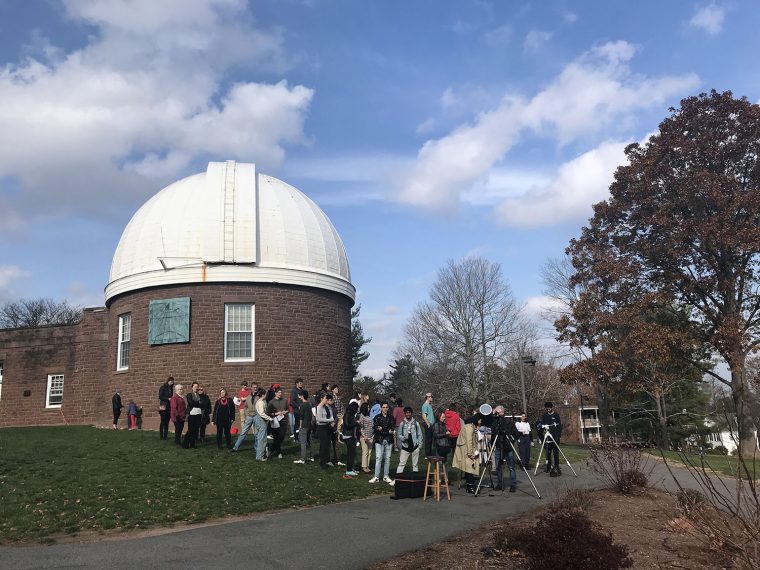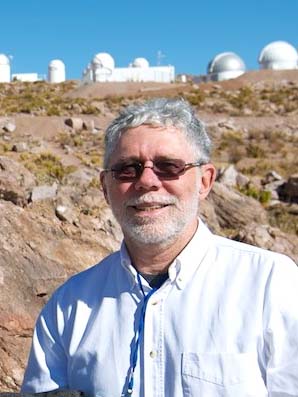Three Wesleyan faculty were honored with the Wesleyan Prize for Excellence in Research in October. The third annual prize is similar to the Binswanger Prize for Excellence in Teaching, but is presented to members of the faculty who demonstrate the highest standards of excellence in their research, scholarship, and contributions to their field. Each recipient received a plaque and citation as well as research funds for their award. This year's recipients include: Division I, Sumarsam, Winslow-Kaplan Professor of Music; Division II, Lori Gruen, William Griffin Professor of Philosophy; and Division III, Bill Herbst, John Monroe Van Vleck Professor of Astronomy.…
For only the seventh time since Wesleyan’s founding, the planet Mercury passed directly in front of the sun, from the perspective of Earth—and Wesleyan served as a gathering place from which to learn about and observe the event. Faculty and students from Wesleyan’s astronomy department, as well as others from the University and the greater Middletown community, gathered outside the Van Vleck Observatory on Nov. 11 to witness the transit through three telescopes. The mild weather and partly cloudy conditions—particularly at the beginning and end of the transit (which lasted from 7:35 a.m. to 1:04 p.m.)—made for good viewings through…
Wesleyan faculty frequently publish articles based on their scholarship in The Conversation US, a nonprofit news organization with the tagline, “Academic rigor, journalistic flair.” In a new article, John Monroe Van Vleck Professor of Astronomy Bill Herbst and Assistant Professor of Earth and Environmental Sciences James Greenwood write about the model they've proposed for how the most common kind of meteorites form—a mystery that has dogged scientists for decades. The tell-tale clue to how meteorites were made, at the birth of the solar system April 26, 1803 was an unusual day in the small town of L’Aigle in Normandy, France – it…
A paper by John Monroe Van Vleck Professor of Astronomy William Herbst and Assistant Professor of Earth and Environmental Sciences James Greenwood will be published in the September 2019 issue of Icarus, published by Elsevier. The paper is available online. The paper, titled "Radiative Heating Model for Chondrule and Chondrite Formation," presents a new theory of how chondrules and chondrites (the most common meteorites) formed. It suggests a new approach to thinking about these rocks that populate the meteorite collections on Earth. It includes both theory and experiments (completed in Greenwood's lab in Exley Science Center). These laboratory experiments demonstrate that porphyritic olivine…
Jim Greenwood, assistant professor of earth and environmental sciences, and Bill Herbst, the John Monroe Van Vleck Professor of Astronomy, professor of integrative sciences, have received a research award from NASA in the amount of $550,000 for a program titled “Experimental simulations of chondrule formation by radiative heating of hot planetesimals." The grant will allow Greenwood and Herbst to hire a post-doctoral fellow who will work in Greenwood’s lab in Exley Science Center to reproduce chondrules — small spherules of melted rock that formed early in the history of the solar system and hold clues to the origin of the planets.…
Bill Herbst, the John Monroe Van Vleck Professor of Astronomy; Martha Gilmore, the George I. Seney Professor of Geology; Wilson Cauley, a post-doctoral fellow; and Nicole Arulanantham MA ’15 are the co-authors of a paper forthcoming in The Astrophysical Journal. The paper is based on Arulanantham's thesis research at Wesleyan. The paper also was featured in the December newsletter of the Gemini Observatory, an international observatory based in Hawaii and Chile. “The subject of the paper, a star known as KH 15D, was recognized as an important and interesting object in the 1990s through observations made on the Wesleyan campus by undergraduate and graduate students,” Herbst explained.…
Bill Herbst, the John Monroe Van Vleck Professor of Astronomy, and James Greenwood, assistant professor of earth and environmental sciences, co-authored an article published in the planetary science journal Icarus. Their article, “A New Mechanism for Chondrule Formation: Radiative Heating by Hot Planetesimals” grew out of research seminars from the recently introduced Planetary Science graduate concentration and minor at Wesleyan. Their work focused on chondrules, or tiny spheres of molten rock that permeate primitive meteorites and date to very close to the beginning of the solar system. For decades, the existence of chondrules has puzzled astrophysicists and cosmochemists as no…
Astronomy magazine has an in-depth feature in its October issue on Wesleyan's astronomical history and the restoration of its century-old, 20-inch refractor telescope, just in time for the Van Vleck Observatory's centennial observation this spring. Telescopes like Wesleyan's 28-foot-long, two-ton refractor had once been cutting edge, and a source of pride for dozens of American universities. But as they "staggered into obsolescence" over the past half century, institutions have had to make tough choices about whether to renovate or retire them. In 2014, Wesleyan hired Chris Ray and Fred Orthlieb of Pennsylvania to give its refractor a second life. The story traces the history…
Biology Ph.D candidate Sarah Kopac was invited to speak at the 2014 Spring Symposium of the Space Telescope Science Institute on the campus of Johns Hopkins University in Baltimore, M.D. on April 29. Kopac spoke on "Specialization of Bacillus in the Geochemcially Challenged Environment of Death Valley." Watch a video of her 20 minute presentation online here. Kopac's talk was part of a four-day interdisciplinary meeting titled "Habitable Worlds Across Time and Space" featuring speakers from around the world working in such diverse fields as biology, geology and astronomy. The focus of the seminar was on identifying places within our…
Bill Herbst, the John Monroe Van Vleck Professor of Astronomy, director of graduate studies, received a $5,000 grant from NASA's Jet Propulsion Laboratory to support observations with the Spitzer Space Telescope. The title of the proposal is “Planet Formation in the Circumbinary Disk of KH 15D.” Herbst and his colleagues are measuring the brightness of the T Tauri binary system KH 15D covering several important missing orbital phases around minimum light and one near maximum. Data is crucial to understanding the mechanisms behind the observed reddening in the system, which has implications for planetformation and disk evolution. Learn more about this study online here.
On a feature for Fox 61, Seth Redfield, assistant professor of astronomy, and Bill Herbst, chair and the John Monroe Van Vleck Professor of Astronomy, discussed the transit of Venus across the Sun, and showed viewers how Wesleyan would be marking the event with public viewings from Van Vleck Observatory. "So here we have a case, where we can see the affect of a planet on a star, close up," Herbst said in the feature, which aired on June 5. The next transit won't happen intil 2017. "It's a very wonderful opportunity to learn something new about planets and their atmospheres and…
Bill Herbst, the John Monroe Van Vleck Professor of Astronomy, chair of the Astronomy Department, is the author of "Infrared Variability of Evolved Protoplanetary Disks: Evidence for Scale Height Variations in the Inner Disk," published in The Astrophysical Journal, Volume 748, Issue 1, article id. 71, 2012. Roy Kilgard, research assistant professor of astronomy, is the author of "Chandra Observations of the Collisional Ring Galaxy NGC 922," published in The Astrophysical Journal, Volume 747, Issue 2, article id. 150, 2012.




